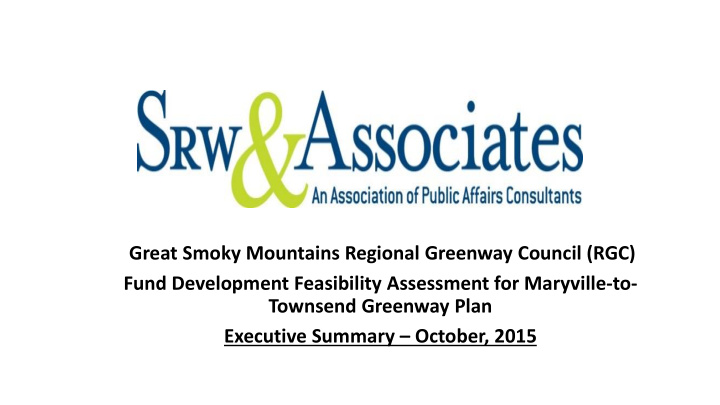



Great Smoky Mountains Regional Greenway Council (RGC) Fund Development Feasibility Assessment for Maryville-to- Townsend Greenway Plan Executive Summary – October, 2015
A Gateway into Townsend
Widespread Support Exists • All local governments in Blount County • Master Plan has community buy-in • TN Governor Haslam, General Assembly and Departments of Tourism, Economic & Community Development and Environment & Conservation “GET” the Impact and Value of Recreational Tourism • Members of Blount County state legislative delegation support • Great Smoky Mountains National Park Leadership Endorses • Congressional delegation supportive for existing federal grants
Economic Impact $2.66 for Every $1 in Construction Spending
Project Benefits Increase Grant Eligibility TDOT, TDEC and TECD Programs • Part of larger regional master plan linking multiple counties • Public Lands • Connections to local schools and Maryville College • Connections to retail, employment centers, hospital & related offices • Connections to local parks • Connection to Great Smoky Mountains National Park • Potential Economic Impact
State & Federal Grant Potential Most Likely Programs • US DOT Tiger Grant Program – 50/50% match ranging about $10-$15 million level • TDOT Multi-Modal Access Fund – 95/5% match with $1 million cap per grant • TDEC Recreational Trails Program – 80/20% match, typically $200,000 • TDEC Local Parks and Recreation Fund – 50/50% match • TDOT Safe Routes to Schools – 100% funding & are capped at $250,000 per project • Transportation Alternatives – 80/20 match with average award approximately $350,000 • TECD newly established Rural Development Fund – Announced Oct. 2015 with $1 million set-aside for Tourism Development. • The TIFIA program (Transportation Infrastructure Finance and Innovation Act – a revolving fund that finances transportation projects, including greenways), recently updated to enable it to be better utilized by rural areas and more accessible for small projects as part of US DOT “FAST Act” passed by Congress in December 2015.
Plan Cost is Greatest Challenge
Alternative Building Products Could Achieve Reduced Cost for Phase 3 • Explore customized manufactured aluminum bridges for cantilevered section • Lighter weight/pre-fabricated for remote and steep locations • Longer span • Smaller installation crews and equipment • Decking can be customized to aesthetic needed
Pedestrian bridge - Golden Gate National Park Gator Bridge Case Study
Private Sector Financial Support Potential Second Most Challenging Issue • Projected to represent $3-5 million or 15-20% of project cost • Small pool (less than 20) of corporate headquarters and private foundations for the larger gifts – $1 million or more. • Need assurance that all other funding can be secured to complete the project • Small to Medium Size Business Corporate Support Opportunities include: • Sale of “Naming Rights Sponsorships “ for bridges, pavilions, trail markers, benches, trailhead pavers have been successful in other communities • In-kind Support such as contributions of products and services – building materials, landscaping, volunteer work groups, etc. can produce cost saving
Private Sector Grassroots Opportunities • Establish “Friends” Group with Annual Membership Drives • Provides Awareness – creates buzz and ongoing support • Dues & Donor Funds – Smaller Gift Levels Add Up • Volunteer Corp for Events • Signature Fundraising Events similar to or in concert with Tour de Blount • Social Media Fundraising – Crowdsourcing Sites such as Go Fund Me or In Our Back Yard (IOBY)
National and TN Project Case Studies Offer Models and Document Success Achieved • All Case Studies document the following similarities and are recommended elements: • A long-term and sustainable public/private partnership to be established; • A committed and connected volunteer group to assist in the private sector fundraising campaign; • A dedicated organization with a full-time staffing component to guide, coordinate and facilitate the work of all the partners. Options include an existing group like the Legacy Parks Foundation, a conservancy, an alliance of local governments, or a new 501(c)(3) non-profit.
Overall Conclusion MTT Regional Greenway Could be Feasible If: • A dedicated full-time staffing component is established under the auspices of a creditable organization with similar mission; • Staffing is funded at the outset by collaboration of local governments; • Majority of funding or 75-80% will have to come from local, state and federal funding; • A strong volunteer fundraising group committed to a long-term effort is organized and raises $3-5 million or 15-20% of the cost; • Strong support from the region’s state legislative delegation willing to seek either legislative or administration set-aside funding; • All potential players are at the table working collaboratively to pursue pieces of funding – local governments, Legacy Parks Foundation, GSMP, Blount Partnership, Little River Watershed Association and Foothill Land Conservancy and more.
Yes It Can Be Done If All The Stars Align!
Next Steps • Approach Legacy Parks Foundation to discuss their interest in being the lead agency facilitator and funding needed for dedicated staffing. • Develop a one- to three-year Funding Campaign Master Plan • Identify Lead Agency and Establish Volunteer Leadership Team • Give initial priority to Campaign Plan to secure Year 1 funding for lead agency staffing component for the project. • Identify with RGC and TPO the initial priorities for TDOT and TDEC grant submission and local government responsibilities • Outline the strategies, tactics and timeline for the Campaign Master Plan • Engage the region’s legislative delegation regarding support of other legislative solutions for designated funding when timing is right.
Recommend
More recommend